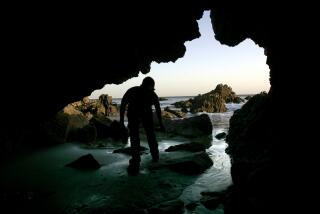Forest-Fee Plan Stirs Up Foes
- Share via
WASHINGTON — Fees to hike, swim or camp at national forests or parks could become a permanent part of the summer recreation scene under legislation pending in Congress.
Visitors are charged fees now at some places, including the Grand Canyon in Arizona and Mount St. Helens National Volcanic Monument in Washington state, through a pilot program started in 1996. Supporters say the money goes to pay for such things as repaving access roads, replacing boat docks and other needed maintenance and improvements.
A bill pending in Congress would make those fees permanent and extend the option to charge for recreation on federal lands that now are free.
Rep. Ralph Regula, the Ohio Republican who created the pilot program, says maintenance, such as clearing debris from trails and updating plumbing systems, is postponed each year because of lack of funding. The maintenance backlog ranges from $13 billion to $16 billion, most of it for National Park Service and U.S. Forest Service needs.
“Most of these park fees are very minimal, and the people who are going there are not people who are from poverty row,” Regula said. He said there would be discounts for seniors or school groups.
The pilot program has been renewed each year without opposition, suggesting Congress would authorize a permanent program. It’s not clear, however, whether lawmakers would consider the bill during an election year.
Opposition to the proposal centers on complaints that the program has done nothing to eliminate maintenance backlogs while it essentially transforms vast tracts of land that used to be freely accessible into paid preserves.
“Out West, you just walk up over a hill and you are in federal land. You can fish, hike, hunt. And suddenly you have to pay a fee for that. I think people are having a hard time understanding that,” said Aubrey C. King, director of the National Alliance of Gateway Communities, which represents residents who live near federal lands.
The Park Service and Forest Service, the Fish and Wildlife Service and Bureau of Land Management have collected about $1 billion through the pilot program, paying for trail maintenance, replacing fire rings with grills, installing new picnic tables and updating exhibits.
Visitation has remained constant in the last decade at about 360 million people to recreation areas maintained by the Park Service, Fish and Wildlife and Bureau of Land Management, according to a 2003 report from the those agencies.
The fees could be $5 a day or $35 a year, depending on whether visitors pay per car as they enter the land or buy an annual pass.
Reports from the Government Accounting Office, which is Congress’ investigative arm, say it’s not clear whether the fee program has helped agencies catch up on their maintenance needs.
But Tom Thompson, deputy chief of the national forest system, told lawmakers at a recent hearing that the money has been crucial in allowing the agency to make repairs, improve facilities and safety, and provide educational services.
Thompson said officers at Ohio’s Wayne National Forest used money collected last year to remove fallen trees along 92 miles of trails after an ice storm. Forest spokesman Gary Miller said the project cost $176,000 of the $232,000 raised in fees.
“That ice storm put down thousands of acres of trees. There were piles of debris taller than your head,” Miller said. “We couldn’t have opened the trails in time for summer recreation without those funds.”
Still, some outdoor enthusiasts bristle over the notion that they might have to pay twice for services -- once in fees, and also in taxes.
“It’s anti-American,” said Robert Funkhouser, director of the Norwood, Colo.-based Western Slope No-fee Coalition. “We own the land. We pay our taxes each year to maintain it.”
Tom Cowher, who enjoys taking his two stepsons on off-road motorcycles down trails at the Wayne National Forest, said the program is good in theory but some kinks need to be fixed.
“The improvements haven’t kept pace with the increased usage,” Cowher said. “We haven’t seen additional trail miles, which was one of the goals.”
He also wants to make sure fee revenue can be treated as local matching funds when applying for federal grants. And he opposes the fact that off-road vehicle owners, who already must pay a separate fee to obtain a license to use their vehicles in Ohio, are charged usage fees at the forest while hikers are not.
Other park users agreed that some changes should be made to the program before it became permanent.
Roy Denner, president of the Off-Road Business Assn. based in Santee, Calif., said he was worried that officers at the Imperial Sand Dunes Recreation Area would use the fees for conservation programs and not maintenance or improvements that benefit visitors.
“It really makes sense for the people who pay the fees to have some say in how the fees are spent,” he said.
Others worry that the fees will eventually replace -- instead of supplement -- federal funding. Regula, who used to oversee funding for national lands, says the program is not designed to usurp regular appropriations.
Operating costs for the lands average about $1.2 billion a year for each agency. The agencies’ annual budgets range from $1.3 billion for the Fish and Wildlife Service to $4.5 billion for the Forest Service.
Under Regula’s bill, 80% of the money from fees would have to be used at the park where it is collected. The pilot program also keeps the money at the collection point, and some users are starting to take notice, according to state tourism directors.
“From what we’ve seen and the comments that have come back, we’re enthusiastic that the fees are providing a better experience for the visitors,” said Carl Wilgus, director of tourism for the state of Idaho.
Idaho is one of 13 members of the Western States Tourism Policy Council, which supports the fee program. On the other hand, legislatures in California, Colorado, New Hampshire and Oregon, and dozens of city councils in those states and Arizona and Utah have passed resolutions opposing the program.
Ken Kastorff, who runs rafting trips down the Nantahala River in North Carolina, said folks should accept the fees and move on. “Anybody that thinks that you pay your taxes and you don’t ever have to pay any more into the system for something like this, those days are gone,” he said. “The money has got to come from somewhere.”
More to Read
Sign up for Essential California
The most important California stories and recommendations in your inbox every morning.
You may occasionally receive promotional content from the Los Angeles Times.










